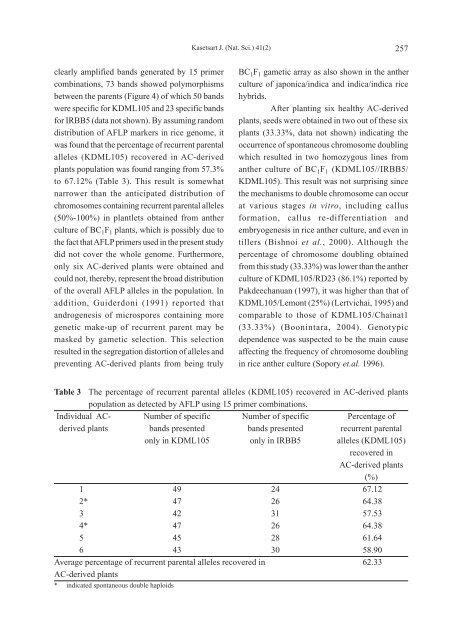April - June 2007 - Kasetsart University
April - June 2007 - Kasetsart University
April - June 2007 - Kasetsart University
You also want an ePaper? Increase the reach of your titles
YUMPU automatically turns print PDFs into web optimized ePapers that Google loves.
clearly amplified bands generated by 15 primer<br />
combinations, 73 bands showed polymorphisms<br />
between the parents (Figure 4) of which 50 bands<br />
were specific for KDML105 and 23 specific bands<br />
for IRBB5 (data not shown). By assuming random<br />
distribution of AFLP markers in rice genome, it<br />
was found that the percentage of recurrent parental<br />
alleles (KDML105) recovered in AC-derived<br />
plants population was found ranging from 57.3%<br />
to 67.12% (Table 3). This result is somewhat<br />
narrower than the anticipated distribution of<br />
chromosomes containing recurrent parental alleles<br />
(50%-100%) in plantlets obtained from anther<br />
culture of BC 1F 1 plants, which is possibly due to<br />
the fact that AFLP primers used in the present study<br />
did not cover the whole genome. Furthermore,<br />
only six AC-derived plants were obtained and<br />
could not, thereby, represent the broad distribution<br />
of the overall AFLP alleles in the population. In<br />
addition, Guiderdoni (1991) reported that<br />
androgenesis of microspores containing more<br />
genetic make-up of recurrent parent may be<br />
masked by gametic selection. This selection<br />
resulted in the segregation distortion of alleles and<br />
preventing AC-derived plants from being truly<br />
<strong>Kasetsart</strong> J. (Nat. Sci.) 41(2) 257<br />
BC 1F 1 gametic array as also shown in the anther<br />
culture of japonica/indica and indica/indica rice<br />
hybrids.<br />
After planting six healthy AC-derived<br />
plants, seeds were obtained in two out of these six<br />
plants (33.33%, data not shown) indicating the<br />
occurrence of spontaneous chromosome doubling<br />
which resulted in two homozygous lines from<br />
anther culture of BC 1F 1 (KDML105//IRBB5/<br />
KDML105). This result was not surprising since<br />
the mechanisms to double chromosome can occur<br />
at various stages in vitro, including callus<br />
formation, callus re-differentiation and<br />
embryogenesis in rice anther culture, and even in<br />
tillers (Bishnoi et al., 2000). Although the<br />
percentage of chromosome doubling obtained<br />
from this study (33.33%) was lower than the anther<br />
culture of KDML105/RD23 (86.1%) reported by<br />
Pakdeechanuan (1997), it was higher than that of<br />
KDML105/Lemont (25%) (Lertvichai, 1995) and<br />
comparable to those of KDML105/Chainat1<br />
(33.33%) (Boonintara, 2004). Genotypic<br />
dependence was suspected to be the main cause<br />
affecting the frequency of chromosome doubling<br />
in rice anther culture (Sopory et.al. 1996).<br />
Table 3 The percentage of recurrent parental alleles (KDML105) recovered in AC-derived plants<br />
population as detected by AFLP using 15 primer combinations.<br />
Individual AC- Number of specific Number of specific Percentage of<br />
derived plants bands presented bands presented recurrent parental<br />
only in KDML105 only in IRBB5 alleles (KDML105)<br />
recovered in<br />
AC-derived plants<br />
(%)<br />
1 49 24 67.12<br />
2* 47 26 64.38<br />
3 42 31 57.53<br />
4* 47 26 64.38<br />
5 45 28 61.64<br />
6 43 30 58.90<br />
Average percentage of recurrent parental alleles recovered in<br />
AC-derived plants<br />
62.33<br />
* indicated spontaneous double haploids
















